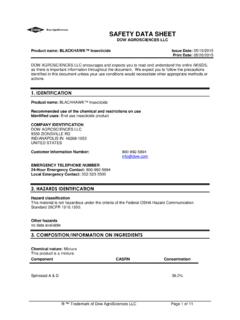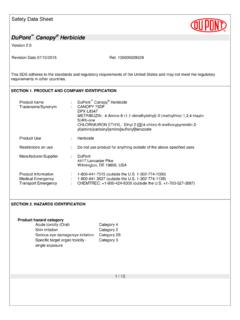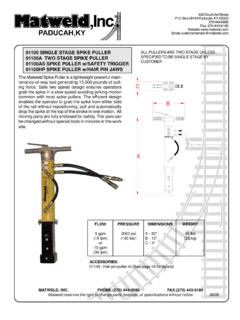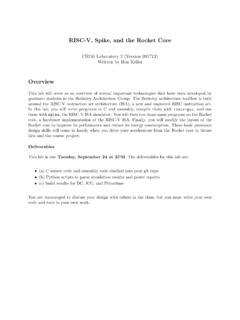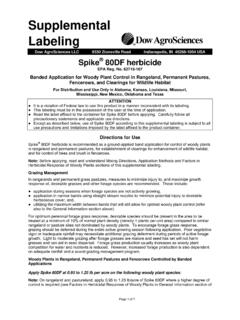Transcription of Improve Rangeland with Spike 20P Herbicide
1 Improve Rangeland withSpike 20P HerbicideBig sagebrush can often reach densities detrimental to the ecological health ofWestern Rangeland areas. At these levels, big sagebrush can reduce productivity,plant and animal diversity, wildlife habitat and soil protection. On the other hand,sagebrush is a native plant and its presence is beneficial in many respects. Ithelps prevent the release of invasive weeds and brush, holds snow in the winter,cycles soil nutrients, and provides safe sites for grasses and forbs. The desireddensity of big sagebrush varies greatly according to management objectives for aparticular site, but it is generally accepted that a variety of sagebrush densities on a landscape scale (amosaic) results in better overall Rangeland health and wildlife habitat.
2 In other words, a balance is 20P Herbicide can help achieve this balance by reducing the canopy cover, or thinning, in heavystands of big sagebrush to allow for enhanced productivity and biodiversity. Spike 20P has proven effective in thinning stands of mountain big sagebrush (Artemisia tridentata,subspecies vaseyana) and Wyoming big sagebrush (Artemisia tridentata, subspecies wyomingensis), butthe effect on other species of sagebrush is variable. If you are unsure which species you have, see thedescriptions below or consult a range specialist for positive identification. Before You Begin Treatment The reduction in canopy cover provided by an application of Spike depends on the amount of Spikeapplied and the amount of soil organic matter (OM).
3 Higher OM requires higher application rates toachieve the same results. Soil OM is determined by laboratory analysis of representative soil samples taken from the top 10 inches ofthe soil profile located under the drip line of the sagebrush canopy. If you have this information, you canuse the data in Table 1 to determine the proper application rate for Spike . Sometimes, obtaining soil OM information is difficult or impractical for various reasons. The good news isthat we have found that the subspecies of big sagebrush, in combination with site elevation, can serve asan indicator of soil organic matter as it relates to how Spike 20P Herbicide performs.
4 If you can determinethe type of sagebrush and the elevation of the site, you can use the data in Table 2 as an alternativemethod to determine the proper application rate for Spike . Mountain big sagebrush (Artemisia tridentatassp. vaseyana) typicallygrows at higher elevations and at sites with higher organic matter. It has an even top like a birthday cake, and leaf margins that arestraight with a slight bulge at the end. Wyoming big sagebrush (Artemisia tridentatassp. wyomingensis)typically grows at lower elevations with lower soil organic matter. It has an uneven top, with leaf margins that are belled TablesThe following tables show recommended application rates of Spike 20P Herbicide to achieve variousreductions in sagebrush canopy cover.
5 Sagebrush canopy cover in the range of 10 percent to 15 percent isgenerally considered to be optimal for biodiversity. Forage production is usually maximized in this range aswell. In other words, forage availability will not significantly increase as more sagebrush is removed. Thespecified levels of canopy cover reduction are approximate and will vary with the differences in soil texture,depth and moisture, slope and aspect. Remember that for a given application rate (and correspondingpercent canopy cover reduction), starting canopy cover determines ending canopy cover (see examplesbelow for further clarification).
6 Rates presented are in pounds of formulated 1. Application Rates of Spike 20P Required to Achieve Specified Levels of Canopy Cover Reduction, by Soil Organic Matter Table 2. Application Rates of Spike 20P Required to Achieve Specified Levels of Canopy Cover Reduction, by Big Sagebrush Subspecies and Site ElevationPlease note, accurate application is important with Spike 20P Herbicide . Unacceptable impact onnontarget species may occur at application rates that exceed the site recommendations shown above. Here are some examples of how to determine the proper rate of Spike 20P for your 1 (using soil OM information): The site has 4 percent organic matter in the top 10 inches of soil canopy cover of big sagebrush is 20 percent.
7 The objective is to obtain 10 percent canopy cover. Toachieve this, the canopy cover must be reduced by 50 percent. Table 1 shows that to obtain a 50 percentreduction in canopy cover at 4 percent OM, the recommended application rate is lbs. of Spike 20P per 2 (using subspecies and elevation information):This is a mountain big sagebrush site over 6,500 Present canopy cover is 30 percent. It is desirable to reduce density by 50 percent, thereby leaving 15 percent canopy remaining. Table 2 shows that to obtain a 50 percent reduction in canopy cover, therecommended application rate is lbs.
8 Of Spike 20P per acre. Note that higher levels of canopy reductioncannot be achieved at recommended rates in this situation. *Trademark of Dow AgroSciences LLCA lways read and follow label on front reprinted with permission of Winward from a xerographic copy ofUniv. of Idaho, FWR Bull. No. 35, (7/04) BR532-C2-205-04 010-56042 Percentage reduction in canopy cover40%50%75%85%Soil Organic Matter application rate of Spike 20P in pounds per acre <3% to to 5% >5% reduction in canopy cover40%50%75%85%Subspecies/Elevation application rate of Spike 20P in pounds per acre wyomingensis / <6500 / >6500 / <6500 / >6500 Not recommended due to lack of data showing percent reduction under these Not recommended due to lack of data showing percent reduction under these conditions.








